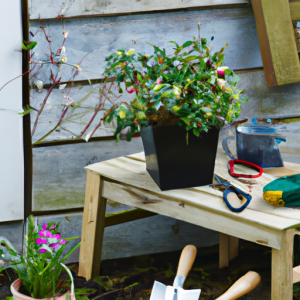“Be Fire-Safe: Inspect, Prepare, and Prevent!”
Introduction
Fire safety is an important part of keeping your home safe and secure. Taking the time to understand the risks and how to prevent them can help you protect your family and your home from the dangers of fire. There are several steps you can take to help prevent a fire from occurring in your home. These include ensuring that all electrical appliances are in good working order, keeping flammable materials away from heat sources, and having a working smoke alarm. By taking these steps, you can help reduce the risk of a fire occurring in your home.
Install Smoke Alarms: Smoke alarms are essential for detecting fires early and alerting you and your family to evacuate. Make sure to install smoke alarms on every level of your home
Smoke alarms are an essential part of any home safety plan. They provide early warning of a fire, allowing occupants to evacuate quickly and safely. It is important to install smoke alarms on every level of the home, including the basement, to ensure that all occupants are alerted in the event of a fire.
When installing smoke alarms, it is important to follow the manufacturer’s instructions carefully. This includes ensuring that the alarm is placed in the correct location, such as near the ceiling or on the wall. It is also important to test the alarm regularly to ensure that it is working properly.
In addition to installing smoke alarms, it is important to have a plan in place for what to do in the event of a fire. This includes having an evacuation plan and a designated meeting place outside of the home. It is also important to practice the plan regularly to ensure that everyone in the home knows what to do in the event of a fire.
By installing smoke alarms and having a plan in place, you can help ensure the safety of your family in the event of a fire.
and test them regularly to ensure they are working properly.
It is important to ensure that safety systems are working properly in order to protect people and property. Regular testing of safety systems is essential to ensure that they are functioning correctly and are able to respond to any potential hazards. Testing should be conducted on a regular basis to ensure that the safety systems are up to date and functioning as intended.
When testing safety systems, it is important to consider the type of system being tested and the environment in which it is being used. Different types of safety systems may require different testing methods and procedures. For example, fire alarm systems may require testing of the sensors, wiring, and other components to ensure that they are working properly. Similarly, security systems may require testing of the cameras, motion detectors, and other components to ensure that they are functioning correctly.
It is also important to consider the frequency of testing. Depending on the type of safety system, testing may need to be conducted on a daily, weekly, or monthly basis. Additionally, testing should be conducted after any changes or updates have been made to the system. This will ensure that the system is functioning as intended and is able to respond to any potential hazards.
Finally, it is important to document the results of the testing. This will provide a record of the system’s performance and can be used to identify any areas that need improvement. Additionally, documenting the results of the testing can help to ensure that the safety systems are functioning properly and are able to respond to any potential hazards.
The use of technology in the classroom has become increasingly popular in recent years, and for good reason. Technology can be used to enhance the learning experience, providing students with access to a wealth of information and resources. It can also be used to facilitate collaboration and communication between students and teachers. However, there are some potential drawbacks to using technology in the classroom.
One of the main drawbacks of using technology in the classroom is the potential for distraction. With the availability of the internet, students may be tempted to use their devices for activities unrelated to the lesson. This can lead to a decrease in focus and productivity, as well as a decrease in overall learning. Additionally, technology can be expensive, and not all schools have the resources to provide students with the necessary devices.
Another potential drawback of using technology in the classroom is the potential for cyberbullying. With the increased use of social media, students may be more likely to engage in online bullying or harassment. This can have a negative impact on the learning environment, as well as the mental health of students.
Finally, technology can be a double-edged sword. While it can be used to enhance the learning experience, it can also be used to facilitate cheating. With the availability of online resources, students may be more likely to copy and paste information from the internet, rather than engaging in critical thinking and problem-solving.
Overall, while technology can be a useful tool in the classroom, it is important to consider the potential drawbacks before implementing it. Educators should be aware of the potential for distraction, cyberbullying, and cheating, and take steps to mitigate these risks. Additionally, educators should ensure that students have access to the necessary devices and resources to make the most of technology in the classroom.
Practice Fire Safety: Make sure to practice fire safety in your home by keeping flammable items away from heat sources
Practicing fire safety in the home is essential for protecting lives and property. To ensure safety, it is important to keep flammable items away from heat sources. This includes items such as paper, cardboard, fabrics, and other combustible materials. Additionally, it is important to keep combustible liquids, such as gasoline, paint, and cleaning supplies, in a secure location away from heat sources.
It is also important to install and maintain smoke detectors and fire extinguishers in the home. Smoke detectors should be tested regularly and replaced every 10 years. Fire extinguishers should be inspected annually and recharged as needed.
Finally, it is important to create and practice a fire escape plan. All family members should be aware of the plan and practice it regularly. This plan should include two ways out of each room and a designated meeting place outside the home.
By following these simple steps, families can ensure that their homes are safe from the threat of fire.
Such as stoves and space heaters. Additionally
The use of combustible fuel sources for heating and cooking is a major contributor to indoor air pollution. In many parts of the world, the burning of wood, coal, and other solid fuels is the primary source of energy for cooking and heating. This burning process releases a variety of pollutants, including particulate matter, carbon monoxide, nitrogen dioxide, and sulfur dioxide. These pollutants can have serious health effects, including respiratory and cardiovascular diseases, as well as cancer.
In order to reduce the health risks associated with indoor air pollution, it is important to reduce the use of combustible fuel sources. This can be done by increasing access to cleaner energy sources, such as electricity and natural gas. Additionally, the use of improved stoves and space heaters can reduce the amount of pollutants released into the air. Improved stoves and space heaters are designed to burn fuel more efficiently, resulting in fewer pollutants being released into the air.
Finally, it is important to ensure that combustible fuel sources are used safely. This includes proper ventilation, as well as regular maintenance and cleaning of stoves and space heaters. Additionally, it is important to ensure that combustible fuel sources are stored properly and away from sources of ignition.
In conclusion, the use of combustible fuel sources for heating and cooking can lead to serious health risks due to indoor air pollution. In order to reduce these risks, it is important to reduce the use of combustible fuel sources and increase access to cleaner energy sources. Additionally, improved stoves and space heaters should be used, and combustible fuel sources should be stored and used safely.
Never leave candles or cooking appliances unattended.
It is important to be mindful of safety when using candles and cooking appliances. Leaving these items unattended can lead to dangerous situations, such as fires or burns. It is essential to be aware of the potential risks and take the necessary precautions to ensure safety.
When using candles, it is important to keep them away from flammable materials, such as curtains or furniture. It is also important to keep them away from children and pets. Additionally, it is important to never leave a lit candle unattended. If you must leave the room, be sure to extinguish the flame before doing so.
When using cooking appliances, it is important to be aware of the potential risks. It is important to keep the area around the appliance clear of flammable materials, such as paper towels or dishcloths. Additionally, it is important to never leave the appliance unattended while it is in use. If you must leave the room, be sure to turn off the appliance before doing so.
In conclusion, it is important to be mindful of safety when using candles and cooking appliances. Leaving these items unattended can lead to dangerous situations, such as fires or burns. It is essential to be aware of the potential risks and take the necessary precautions to ensure safety.
Conclusion
Fire prevention is an important part of keeping your home safe. By following the three steps of fire prevention, you can help to reduce the risk of a fire occurring in your home. These steps include ensuring that all electrical appliances are in good working order, keeping flammable materials away from heat sources, and having a working smoke alarm installed. Taking these steps can help to keep your home and family safe from the dangers of fire.






